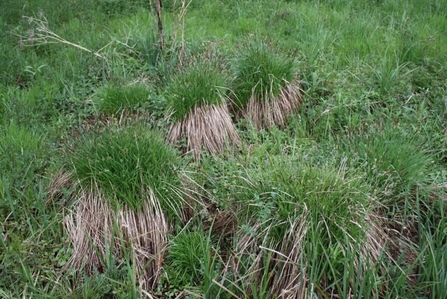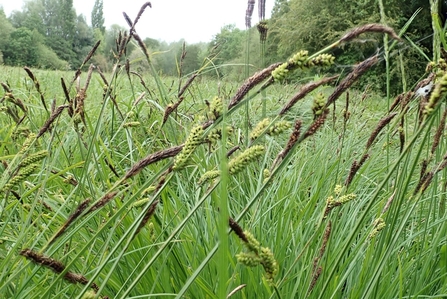
Tussocks of long Tufted Sedge grass

Tussocks of long Tufted Sedge grass
Our project aims to save a critically endangered plant, Carex cespitosa (Scarce Tufted-sedge), from extinction in the UK. Currently, Carex cespitosa is only found on one site in the whole of the UK, here in Hertfordshire. This location is a privately-owned county Local Wildlife Site, and both the careful owners and the Wildlife Trust realise we have a duty to ensure its survival. It’s part of our responsibility to future generations, so that they will be able to experience the full breadth of UK biodiversity. It’s also a continuing part of our strategy to restore 30% of land for nature by 2030.
Carex cespitosa is a Tufted-sedge, seen growing as tussocks in water-logged habitats. Tussocks form over many years, creating little islands lifting the plant away from the water, and preventing it from being drowned. In this way it can grow without competition from other plants, with regular spacings naturally forming between individuals. Pre-history, you could imagine leaping dry-footed across a bog on such structures.
Carex cespitosa can not only be seen as ecosystems engineers but can capture and lay down carbon as the tussocks form. Individuals can be long-lived, with close relatives living to at least fifty years. Sadly however, it seems that the squelch is starting to disappear at our site in Hertfordshire, and it is that sogginess that tussocks of Carex cespitosa need.

Scarce Tufted-sedge © Astrid Biddle
First recorded in Hertfordshire by the late Trevor James, pictures from the relatively recent past show that they stood as little, regularly-spaced islands across pools of shallow water. Today things are different; the ground feels solid under foot and much less seed is being produced, probably because the plants are now stressed. As the ground dries other plants move in and the space they need is lost. Climate change and our increasing demands for water have lowered water tables. Combining this with the historic construction of a railway embankment here, the route of seed transport using the nearby river has been cut off. This means that without our help this plant could become extinct in the UK. We will do what we can for the current site, but at the same time we need an insurance.

Through a programme of surveying, habitat preparation, and then assisted colonisation, we will deliver four distinct populations of Carex cespitosa across Hertfordshire. We have already begun! Our cool spring gave Carex cespitosa a respite from the drying conditions, with a huge abundance of seeds produced. This was important as it means that seed could be collected from lots of different individuals, giving the widest possible genetic diversity and health for future populations. They are now with a specialist nursery for wetland plants and about a month since collection, have germinated.
Muddy hollows are magical places in nature, crucibles from which our first life forms emerged. Wetlands are now our most vulnerable habitats, degraded across Hertfordshire for over a century and now an early victim of climate change.
With our care of the special and rare plants supported in habitats like these, we seek to bring an appreciation of their value, not only as the green backdrop for our other endangered species, or as keystones upon which these species depend, but as the extraordinary and complex marvels in their own right. Using this to build on our experience, we will be able to assist, and where we can, continue to strengthen and connect habitats. Our aim is to leave the land in a better state than before. To that end, it is our ambition to introduce, reintroduce, and reinforce more species in the future.